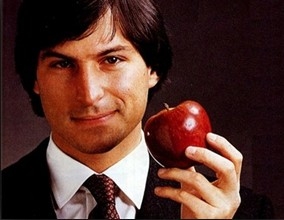The improvements were in not just the details but the entire concept. The mouse at Xerox PARC could not be used to drag a window around the screen. Apple’s engineers devised an interface so you could not only drag windows and files around, you could even drop them into folders. The Xerox system required you to select a command in order to do anything, ranging from resizing a window to changing the extension that located a file. The Apple system transformed the desktop metaphor into virtual reality by allowing you to directly touch, manipulate, drag, and relocate things. And Apple’s engineers worked in tandem with its designers—with Jobs spurring them on daily—to improve the desktop concept by adding delightful icons and menus that pulled down from a bar atop each window and the capability to open files and folders with a double click.
得到提升的并不仅仅是细节,还有整个概念。施乐PARC的鼠标并不能用来在屏幕上拖拽窗口。而苹果工程师们设计出的界面上,用户不仅可以任意拖拽窗口和文件,还可以将它们拖到文件夹中。施乐的系统中,不管是调整窗口的大小还是更改文件的扩展名,用户都必须选择一条指令后才能执行操作。苹果的系统将桌面的概念转化为了虚拟现实,允许用户直接触摸、操作、拖拽和移动文件。苹果的工程师和设计师每天都受到乔布斯的鞭策。他们协同工作,完善了桌面概念:添加了漂亮的图标和位于窗口顶端的下拉菜单,以及双击鼠标打开文件和文件夹的功能。
It’s not as if Xerox executives ignored what their scientists had created at PARC. In fact they did try to capitalize on it, and in the process they showed why good execution is as important as good ideas. In 1981, well before the Apple Lisa or Macintosh, they introduced the Xerox Star, a machine that featured their graphical user interface, mouse, bitmapped display, windows, and desktop metaphor. But it was clunky (it could take minutes to save a large file), costly ($16,595 at retail stores), and aimed mainly at the networked office market. It flopped; only thirty thousand were ever sold.
施乐的管理层并没有忽略他们的科学家在帕克创造出来的东西。事实上,他们的确尝试过利用这些研究成果——而这一过程恰恰证明了为什么好的执行力和杰出的创意同样重要。在苹果的丽萨和麦金塔电脑问世之前,早在1981年,施乐就推出了他们的“施乐之星”(XeroxStar),这台电脑上运用了图形用户界面、鼠标、位图显示、窗口以及桌面概念。但它运行缓慢(保存稍大一点儿的文件需要耗费数分钟),价格昂贵(零售价高达16595美元),且主要瞄准的是计算机网络化的企业市场。它的销售情况十分不好,仅仅卖出去3万台。
Jobs and his team went to a Xerox dealer to look at the Star as soon as it was released. But he deemed it so worthless that he told his colleagues they couldn’t spend the money to buy one. “We were very relieved,” he recalled. “We knew they hadn’t done it right, and that we could—at a fraction of the price.” A few weeks later he called Bob Belleville, one of the hardware designers on the Xerox Star team. “Everything you’ve ever done in your life is shit,” Jobs said, “so why don’t you come work for me?” Belleville did, and so did Larry Tesler.
施乐之星刚刚发布,乔布斯和他的团队就去一家施乐经销商那里查看情况。但他觉得这台机器毫无价值,他告诉同事们根本犯不着花钱买一台。“我们都松了一口气,”他回忆说,“我们看得出来,施乐没能把产品做好,但我们可以,而且价格要便宜得多。”几个星期之后,乔布斯给施乐之星团队的硬件设计师之一鲍勃·贝尔维尔(BobBelleville)去了电话。“你这一辈子做出来的东西都是垃圾,”乔布斯说,“干脆来为我工作吧。”贝尔维尔同意了,一起跳槽的还有拉里·特斯勒。
In his excitement, Jobs began to take over the daily management of the Lisa project, which was being run by John Couch, the former HP engineer. Ignoring Couch, he dealt directly with Atkinson and Tesler to insert his own ideas, especially on Lisa’s graphical interface design. “He would call me at all hours, 2 a.m. or 5 a.m.,” said Tesler. “I loved it. But it upset my bosses at the Lisa division.” Jobs was told to stop making out-of-channel calls. He held himself back for a while, but not for long.
乔布斯十分兴奋,开始插手丽萨项目的日常管理,该项目当时的负责人是曾经的惠普工程师约翰·库奇。乔布斯完全忽略了库奇的存在,直接与阿特金森和特斯勒通气,灌输自己的想法,尤其是关于丽萨的图形界面设计。“他会在任何时间给我打电话,凌晨两点或者早上5点,”特斯勒说,“我喜欢这样。但是丽萨项目的头儿们不高兴了。”乔布斯被要求停止越级管理。他安静了一段时间,但很快又按捺不住了。
One important showdown occurred when Atkinson decided that the screen should have a white background rather than a dark one. This would allow an attribute that both Atkinson and Jobs wanted: WYSIWYG, pronounced “wiz-ee-wig,” an acronym for “What you see is what you get.” What you saw on the screen was what you’d get when you printed it out. “The hardware team screamed bloody murder,” Atkinson recalled. “They said it would force us to use a phosphor that was a lot less persistent and would flicker more.” So Atkinson enlisted Jobs, who came down on his side. The hardware folks grumbled, but then went off and figured it out. “Steve wasn’t much of an engineer himself, but he was very good at assessing people’s answers. He could tell whether the engineers were defensive or unsure of themselves.”
阿特金森认为应该把屏幕的深色背景换成白色的,这引发了一次重大冲突。屏幕背景色的改变可以实现阿特金森和乔布斯都想要的一个特性:WYSIWYG,这是“所见即所得”(WhatYouSeeIsWhatYouGet)的缩写。你在屏幕上看到的是什么样,打印出来就还是什么样。“硬件团队一片哀嚎,”阿特金森回忆说,“他们说,这样的话就必须使用一种持久性差且闪烁严重的磷光体。”阿特金森只好搬来乔布斯帮忙,乔布斯自然站在了他的一边。硬件团队抱怨连连,但之后还是实现了这个功能。“乔布斯本人算不上是个工程师,但他十分擅长评估别人的答案。他能看得出来工程师是心存戒备还是缺乏自信。”













